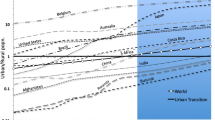Abstract
Across the OECD, Canada’s record on CO2 emissions is particularly poor, with overall emissions up 32% over the 1990–2007 period. The current paper seeks to better understand this situation by making systematic comparisons of Canada with other OECD countries. For Canada overall, the rapid increase in emissions over the 1990–2007 period can be explained by several factors, including major population growth, increased affluence (although to a lesser extent than elsewhere in the OECD), a continued dependence on fossil fuels, while continuing to increase its overall demand for energy. While the energy intensity of Canada’s economy has declined somewhat over recent years, it actually lagged behind most OECD countries on this front and remains one of the most energy intense economies in the world (2nd highest in the OECD on our indicator of energy intensity). While there are many factors responsible for this, Canada’s particularly energy-intensive industrial structure is certainly relevant, as is the importance of its primary sector relative to most developed nations.

Similar content being viewed by others
Notes
As of 2007, the most recent year in which comprehensive data on CO2 emissions and energy use is available, the OECD included 30 countries. More recently, although not included in the current analysis, additional countries have joined the OECD, including Slovenia, Israel, Estonia and Chile, up to 34 countries in 2010.
References
Boyd, D. (2001). Canada vs the OECD: An environmental comparison. Eco-Research Chair of Environmental Policy. University of Victoria, Victorial B.C.
Chertow, M. (2001). The IPAT equation and its variants: Changing views of technology and environmental impact. Journal of Industrial Ecology, 4(4), 13–29.
Commoner, B., Corr, M., & Stamler, P. (1971). The causes of pollution. Environment, 13(3), 2–19.
Demeny, P. (1998). Population size and material standard of living. In P. Demeny & G. McNicoll (Eds.), The Earthscan reader in population and environment (pp. 279–290). London, UK: Taylor and Francis Group.
Dietz, T., & Rosa, E. (1994). Effects of population and affluence on CO2 emissions. Proceedings of the National Academy of Sciences, 94(1), 175–179.
Ehrlich, P. R., & Holdren, J. (1971). Impact of population growth. Science, 171(3977), 1212–1217.
Ehrlich, P., & Holdren, J. (1972). One-dimensional ecology. Bulletin of the Atomic Scientists, 28, 16–27.
Environment Canada. (2006). Canada’s fourth national report on climate change: Actions to meet commitments under the United Nations framework convention on climate change. Ottawa, ON: Environment Canada.
Government of Alberta. (2008). Alberta’s oil sands: Opportunities, balance. Edmonton, Alberta: Government of Alberta.
Hamilton, C., & Turton, H. (2002). Determinants of emissions growth in OECD countries. Energy Policy, 30, 63–71.
Harper, C. L., & Fletcher, T. (2011). Environment and society: Human perspectives on environmental issues. Canadian edition. Toronto: Pearson Canada.
IEA. (2010). Data services, International Energy Association. http://www.iea.org/stats/. Cited July 3, 2011.
IPCC. (1996). Intergovernmental panel on climate change, second assessment. Cambridge, UK: Cambridge University Press.
IPCC. (2000). Intergovernmental panel on climate change: Summary for policymakers. Cambridge, UK: Cambridge University Press.
Karakaya, E., & Ozcag, M. (2005). Driving forces of CO2 emissions in Central Asia: A decomposition analysis of air pollution from fossil fuel combustion. Arid Ecosystems Journal, 11(26), 49–57.
Kaya, Y. (1990). Impact of carbon dioxide emission control on GNP growth: Interpretation of proposed scenarios. Paper presented to the IPCC energy and industry subgroup, response strategies working group, Paris.
MKJA. (2005). Technical report: National circumstances affecting Canada’s greenhouse gas emissions. Vancouver, Canada: M.K. Jaccard and Associates.
National Energy Board. (2006). Canada's oil sands: opportunities and challenges to 2015: An update. Cat. No. NE23-116/2006E.
NRC. (2010). Energy efficiency trends in Canada. Ottawa, ON: Natural Resources Canada, Office of Energy Efficiency.
OECD. (2002). Indicators to measure decoupling of environmental pressure from economic growth. Paris: The OECD Environmental Programme.
OECD. (2010). OECD statextracts. GDP constant US$ PPP adjusted. http://stats.oecd.org. Cited July 3, 2011.
Rees, W. (1992). Ecological footprints and appropriated carrying capacity: What urban economics leaves out. Environment and Urbanization, 4(2), 121–130.
Simon, J. (1981). The ultimate resource. Princeton: Princeton University Press.
Simpson, J., Jaccard, M., & Rivers, N. (2007). Hot air: Meeting Canada’s climate change challenge. Toronto: McClelland and Stewart Ltd.
Smil, V. (2010). Energy myth and realities: Bringing science to the energy policy debate. Washington, DC: AEI American Enterprise Institute.
UN. (2010). Population data on-line. Department of Economic and Social Affairs, Population Division, Population Estimates and Projections Section.
United Nations Framework Convention on Climate Change. (1992). United Nations Environmental Program. Geneva: UNEP.
World Commission on Environment and Development. (1987). From one earth to one world: An overview. Oxford: Oxford University Press.
Yale Centre for Environmental Law and Policy. (2010). Environmental performance index. Yale University, New Haven, CT. http://epi.yale.edu/. Cited July 3, 2011.
York, R., Rosa, E., & Dietz, T. (2003). STIRPAT, IPAT AND ImPACT: Analytic tools for unpacing the driving forces of environmental impacts. Ecological Economics, 46, 351–365.
Author information
Authors and Affiliations
Corresponding author
Rights and permissions
About this article
Cite this article
Kerr, D., Mellon, H. Energy, population and the environment: exploring Canada’s record on CO2 emissions and energy use relative to other OECD countries. Popul Environ 34, 257–278 (2012). https://doi.org/10.1007/s11111-011-0160-2
Published:
Issue Date:
DOI: https://doi.org/10.1007/s11111-011-0160-2




